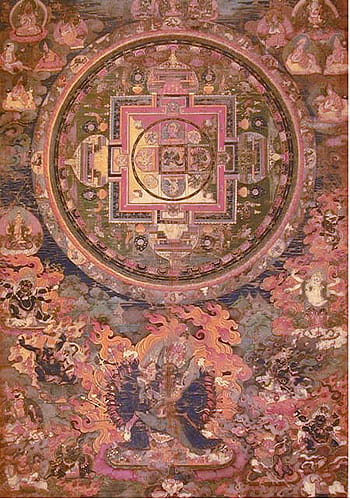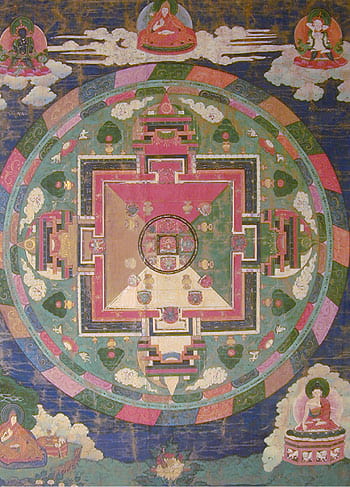Buddhist Objects
Suggested Grade Level: 6th Grade
Subject: World History and Geography: Ancient Civilizations
Estimated Time: 1 class period


Yamantaka Mandala
Tibet, c. 1725
Color on cloth
Pacific Asia Museum Collection
Gift of Dr. and Mrs. Jesse L. Greenstein, 1996.8.6
Painting of a Buddhist Mandala
Tibet, 18th century,
Ink and gold on paper
Pacific Asia Museum Collection
Estate of Mr. and Mrs. Wilmont Gordon, 1990.14.57
Introduction
Buddhists in Tibet, Nepal, China, and Japan use mandalas as diagrams or models of a perfected environment, most often a symbolic depiction of the world of a particular Buddhist deity. They help worshipers practice concentration and cultivate inner vision, picturing themselves present within the perfected environment. From here, the deity can help them to progress toward a state of enlightenment.
Mandalas can be paintings or made of sand, wood, sugar and butter, and many other materials.
Lesson Objectives
Understand an important device some Buddhists use to understand their cosmos.
Key Terms
Cosmos
Enlightenment
Mandala
Meditation
Discussion
Discuss with students the concept that a mandala is a map of a perfect environment. A Buddhist meditating on one of these mandalas might start with the outer ring, which symbolizes the everyday world. They picture themselves moving closer to the center of the mandala. They might imagine they are entering a huge palace and passing through many gates and doors to find treasure inside.
Ask students to look closely at the mandalas. What objects do they see? By looking closely, they can identify clouds, gates, and figures.
Based on their studies of Buddhist cultures, what do they understand by the concept of a “perfect environment”? What would they expect to find in this environment? What would be their own idea of a “perfect environment”? What objects would be there? What kind of landscape would it have? Who would live there?
Standards
Students in grade six expand their understanding of history by studying the people and events that ushered in the dawn of the major western and non-western ancient civilizations. Geography is of special significance in the development of the human story. Continued emphasis is placed on the everyday lives, problems and accomplishments of people, their role in developing social, economic and political structures, as well as in establishing and spreading ideas that helped transform the world forever. Students develop higher levels of critical thinking by considering why civilizations developed where and when they did, why they became dominant and why they declined. Students analyze the interactions among the various cultures, emphasizing their enduring contributions and the link, despite time, between the contemporary and ancient worlds.
6.5 Students analyze the geographic, political, economic, religious, and social structures of the early civilizations of India, in terms of:
the life and moral teachings of Buddha and how Buddhism spread in India, Ceylon, and Central Asia
6.6 Students analyze the geographic, political, economic, religious, and social structures of the early civilizations of China, in terms of:
the diffusion of Buddhism northward to China during the Han dynasty